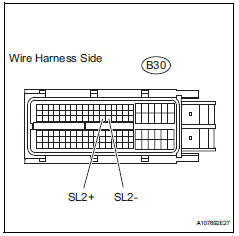Toyota RAV4 (XA40) 2013-2018 Service Manual: Pressure control solenoid "b" electrical (shift solenoid valve sl2)

Description
Shifting from 1st to o/d is performed in combination with the on and off operation of the shift solenoid valves sl1 and sl2, which are controlled by the ecm. If an open or short circuit occurs in any of the shift solenoid valves, the ecm controls the remaining normal shift solenoid valves to allow the vehicle to be operated safely (see page ax-31).

Monitor description
This dtc indicates an open or short in the shift solenoid valve sl2 circuit. The ecm commands gear shifts by turning the shift solenoid valves on/off. When there is an open or short circuit in any shift solenoid valve circuit, the ecm detects the problem, illuminates the mil and stores the dtc. Also, the ecm performs the fail-safe function and turns the other normal shift solenoid valves on/off. In case of an open or short circuit, the ecm stops sending current to the circuit (see page ax-31).
Monitor strategy

Typical enabling conditions

Typical malfunction thresholds
![]()
Component operating range
![]()
Wiring diagram

Inspection procedure
- Inspect transmission wire (shift solenoid valve sl2)

- Disconnect the b27 wire connector.
- Measure the resistance of the transmission wire.
Standard resistance 


- Check wire harness (transmission wire - ecm)

- Disconnect the b30 ecm connector.
- Measure the resistance of the wire harness side connector.
Standard resistance 


Replace ecm
- Inspect shift solenoid valve sl2

- Remove the shift solenoid valve sl2.
- Measure the resistance of the solenoid valve.
Standard resistance: 5.0 To 5.6 Ùat 20┬░c (68┬░f)
- Connect the battery's positive (+) lead with a 21 w bulb to terminal 2 and the negative (-) lead to terminal 1 of the solenoid valve connector. Then check that the valve moves and makes an operating noise.
Ok: valve moves and makes operating noise.


Repair or replace transmission wire
 Pressure control solenoid "B" performance (shift solenoid valve sl2)
Pressure control solenoid "B" performance (shift solenoid valve sl2)
Description
The ecm uses signals from the output shaft speed sensor and input speed
sensor to detect the actual
gear position (1st, 2nd, 3rd or o/d gear).
Then the ecm compares the actual g ...
 Intermediate shaft speed sensor "A"
Intermediate shaft speed sensor "A"
Description
This sensor detects the rotation speed of the counter gear. By comparing the
counter gear speed signal
(nc) with the direct clutch speed sensor signal (nt), the ecm detects the shi ...
Other materials:
Center power outlet socket
Components
Removal
Disconnect cable from negative battery
terminal
Caution:
Wait at least 90 seconds after disconnecting the
cable from the negative (-) battery terminal to
prevent airbag and seat belt pretensioner activation.
Remove no. 1 Console upper panel garnish
(see page ...
Defogging the windshield
Set the air outlet selector dial to
position.
Set the outside/recirculated air
mode button to outside air mode if
recirculated air mode is used.
Perform the following operations accordingly:
To adjust the fan speed, turn the fan speed control dial.
To adjust the temperat ...
On-vehicle inspection
Check ignition coil assembly and perform spark test
Notice:
in this section, the terms "cold" and "hot" refer to
the temperature of the coils. "Cold" means
approximately -10 to 50┬░c (14 to 122┬░f). "Hot" means
approximately 50 to 100┬░c (122 to 212┬ ...
